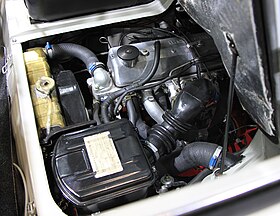Reciprocating internal combustion engine
The Mitsubishi KE engine is a range of engines produced by Mitsubishi Motors during the 1960s and early 1970s. They were extensively used in the various Colt-branded vehicles the company produced from 1963.
The engines were overhead valve iron-blocks, for gasoline and diesel use. The first digit after the KE denotes the number of cylinders, straight-4s becoming KE4 and six-cylinder versions such as the single overhead camshaft 2.0 L straight-6 which was developed in 1964 for the new Mitsubishi Debonair flagship sedan, receiving the KE6 prefix. The last digit is simply a serial, denoting which number engine it is. Some of these engines, such as the two-liter KE42, were further developed into overhead-cam engines and were named Astron.
As a large scale manufacturer, Mitsubishi had a wealth of experience building engines, both gasoline and diesel, in V and straight engine block configurations during the war. One of their many examples was the air-cooled A6120VDe air-cooled inline 6-cylinder 14.4 L diesel and the SA12200VD air-cooled V-12 diesel (21.7 litres).
Specifications
KE41
The KE41 is a diesel engine sharing the dimensions of the KE42 petrol unit.
KE42
The petrol-powered KE42 was first used in the Mitsubishi Jupiter Junior truck beginning in 1963. In 1973, the KE42 was upgraded to meet new emissions regulations and received the MCA (Mitsubishi Clean Air) name to reflect this. Power also increased by 5 hp (4 kW).[3] This engine was developed into an overhead-cam unit, called the Astron 4G52.
KE43
| Engine type
|
Inline four-cylinder OHV
|
| Displacement
|
1.0 L (977 cc)
|
| Bore x stroke
|
72 mm × 60 mm (2.83 in × 2.36 in)
|
| Fuel type
|
Regular gasoline
|
| Peak power
|
51 PS (38 kW) at 6,000 rpm, 1963-1965 Colt 1000 sedan/van[4]
55 PS (40 kW) at 6,000 rpm, 1966 Colt 1000 sedan, all Colt 1000F
|
| Applications
|
1963–1966 Colt 1000, 1966–1969 Colt 1000F
|
KE44
| Engine type
|
Inline four-cylinder OHV
|
| Displacement
|
1.1 L (1,088 cc)
|
| Bore x stroke
|
73 mm × 65 mm (2.87 in × 2.56 in)
|
| Fuel type
|
Regular gasoline
|
| Peak power
|
58 PS (43 kW) at 6,000 rpm
62 PS (46 kW) at 6,000 rpm (1969-1970 non-Sports Colt 11-F)
73 PS (54 kW) at 6,300 rpm (Twin-carb Super Sports, only in Fastback models)
|
| Applications
|
1966–1968 Colt 1100, 1968–1970 Colt 1100F/11-F, 1968–1974 Delica T100
|
KE45
| Engine type
|
Inline four-cylinder OHV
|
| Displacement
|
1.5 L (1,498 cc)
|
| Bore x stroke
|
85 mm × 66 mm (3.35 in × 2.60 in)
|
| Fuel type
|
Regular gasoline
|
| Peak power
|
70 PS (51 kW)
85 PS (63 kW) (Super Sports, twin SU Carburettors)
|
| Applications
|
1965–1969 Colt 1500, 1968-1969 Colt 1500 Super Sports
|
KE46
| Engine type
|
Inline four-cylinder OHV
|
| Displacement
|
1.2 L (1,189 cc)
|
| Bore x stroke
|
73 mm × 71 mm (2.87 in × 2.80 in)
|
| Fuel type
|
Regular gasoline
|
| Peak power
|
62 PS (46 kW) at 6,000 rpm
|
| Peak torque
|
9.6 kg⋅m (94 N⋅m; 69 lb⋅ft) at 3,800 rpm
|
| Applications
|
1968-1970 Colt 1200
|
KE47
The KE47 was largely replaced by the 2.4 liter Astron 4G53 in 1975.[3]
| Engine type
|
Inline four-cylinder OHV
|
| Displacement
|
2.32 L (2,315 cc)
|
| Bore x stroke
|
85 mm × 102 mm (3.35 in × 4.02 in)
|
| Fuel type
|
Regular gasoline
|
| Peak power
|
95 PS (70 kW) at 4,500 rpm
100 PS (74 kW) (1973-1975)
|
| Peak torque
|
17.5 kg⋅m (172 N⋅m; 127 lb⋅ft) at 2,800 rpm
|
| Applications
|
1968-1975 Mitsubishi Canter T90, T200,[3] Jeep, Rosa
|
KE63
| Engine type
|
Inline six-cylinder[5]
|
| Displacement
|
3.5 L (3,520 cc)
|
| Bore x stroke
|
82 mm × 111.1 mm (3.23 in × 4.37 in)
|
| Fuel type
|
Diesel
|
| Peak power
|
92 PS (68 kW) at 3,500 rpm
|
| Peak torque
|
21.5 kg⋅m (211 N⋅m; 156 lb⋅ft) at 2,000 rpm
|
| Applications
|
1963–1968 (?) Mitsubishi Rosa
|
KE64
Derived from the four-cylinder KE43 engine, the bore of the KE64 was increased by 8 mm, giving it an overall displacement of 1,991 cc (2.0 L). The valve layout is similar to Opel's cam-in-head design; the camshaft sits higher than in a regular pushrod engine, alongside the top-dead-center of the pistons, but not above the valves as in an overhead-cam engine.[6] The valves are actuated by short tappets rather than pushrods, allowing for a low engine with some of the more free-revving, smoother characteristics of an SOHC engine.
| Engine type
|
Inline six-cylinder OHV (high-mounted camshaft)
|
| Displacement
|
2.0 L (1,991 cc)
|
| Bore x stroke
|
80 mm × 66 mm (3.15 in × 2.60 in)
|
| Fuel type
|
Regular gasoline
|
| Peak power
|
105 PS (77 kW) at 5,000 rpm
|
| Peak torque
|
16.5 kg⋅m (162 N⋅m; 119 lb⋅ft) at 3,400 rpm
|
| Applications
|
1964–1970 Mitsubishi Debonair (exclusive)
|
KE65
| Engine type
|
Inline six-cylinder[7]
|
| Displacement
|
3.5 L (3,473 cc)
|
| Bore x stroke
|
85 x 102mm
|
| Fuel type
|
Diesel
|
| Peak power
|
95 PS (70 kW) at ??00 rpm
|
| Peak torque
|
??
|
| Applications
|
1968 Mitsubishi Rosa, 1970 Mitsubishi Jupiter T44
|
